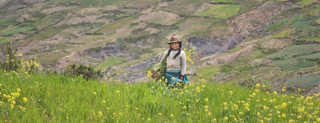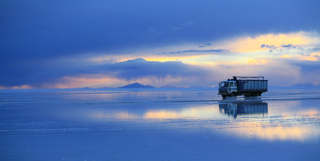“It is a myth that scientists can’t be artists too,” says Dr. Ivar Mendez. “I never found that. Actually, in my experience I’ve found the exact opposite.”
Last week was the book launch of the second edition of Bolivia, a collection of stunning photographs depicting the vistas and citizens of Bolivia taken by Dr. Mendez, a professor in the Departments of Surgery and Anatomy & Neurobiology, and founder of the Ivar Mendez International Foundation. The Foundation provides a breakfast program, dental care, and an art program for children in Bolivia, and the proceeds from sales of Bolivia ($40 per copy) will go to the foundation.
 The photos are a glimpse of the country where Dr. Mendez was born, returns to regularly, and where the foundation does its work. They show the country’s widely different landscapes — from the Salt Flats to rolling green hills — people of all generations, and a number of their traditions. The photos are also a clear indicator of Dr. Mendez’s immense talent as a photographer and an artist.
The photos are a glimpse of the country where Dr. Mendez was born, returns to regularly, and where the foundation does its work. They show the country’s widely different landscapes — from the Salt Flats to rolling green hills — people of all generations, and a number of their traditions. The photos are also a clear indicator of Dr. Mendez’s immense talent as a photographer and an artist.
Bridging science and art
For Dr. Mendez, art and science have always worked hand-in-hand. He sees his scientific work studying the brain as connected with his artistic pursuits in bronze sculpting and photography: both are manifestations of his interest in three-dimensionality. Moreover, he’s always been interested in understanding how the brain, an organic system, could begin to conceptualise or create something that does not already exist.
Conceptualizing that which does not exist is also central to the work of his foundation. “We want to give [the children] a window to a world where they can develop their own minds and imagine something different so they can maybe make it a reality,” says Dr. Mendez.
 The foundation has also worked on the development of a quinoa bar (quinoa is a high-protein grain super-food) that is distributed to the children. Dr. Mendez explained how important it is to ensure children are getting proper nutrition to ensure their brains can develop to their full potential.
The foundation has also worked on the development of a quinoa bar (quinoa is a high-protein grain super-food) that is distributed to the children. Dr. Mendez explained how important it is to ensure children are getting proper nutrition to ensure their brains can develop to their full potential.
The foundation’s three programmes (dental, breakfast, and art) have come to work together in a very complementary fashion. After eating a quinoa bar, the children brush their teeth as part of the dental hygiene they are taught. Then the wrappers from the quinoa bars are saved and used to decorate papier-mâché models of teeth that the children create, giving them an opportunity to be creative as well as learning about teeth at the same time.
Community connections, locally and globally
The book launch celebrated the talents of those who have found ways to straddle the worlds of science and art. The event, held in the Art Gallery of Nova Scotia, featured classical music performed by three Dal medical students: William Blois, Grace Park, and Owen Chauhan.
Joy Laking, a Nova Scotian artist and gallery owner, also attended the launch. Laking recently spent some time teaching the foundation’s art programs in Bolivia.
“It was fantastic to get out there and get to know the kids,” says Laking who, along with her husband, has been involved with the foundation through fundraising efforts in the past.
 The foundation’s work continues to develop in Bolivia. In one of its more recent projects, the foundation has been working to provide pregnant women in remote villages with pre-natal scans and advice from city hospitals using mobile phone tower signals. Dr. Mendez also hopes to see art and education programs similar to the ones created in Bolivia adapted and set up for Inuit children in Canada’s north.
The foundation’s work continues to develop in Bolivia. In one of its more recent projects, the foundation has been working to provide pregnant women in remote villages with pre-natal scans and advice from city hospitals using mobile phone tower signals. Dr. Mendez also hopes to see art and education programs similar to the ones created in Bolivia adapted and set up for Inuit children in Canada’s north.

